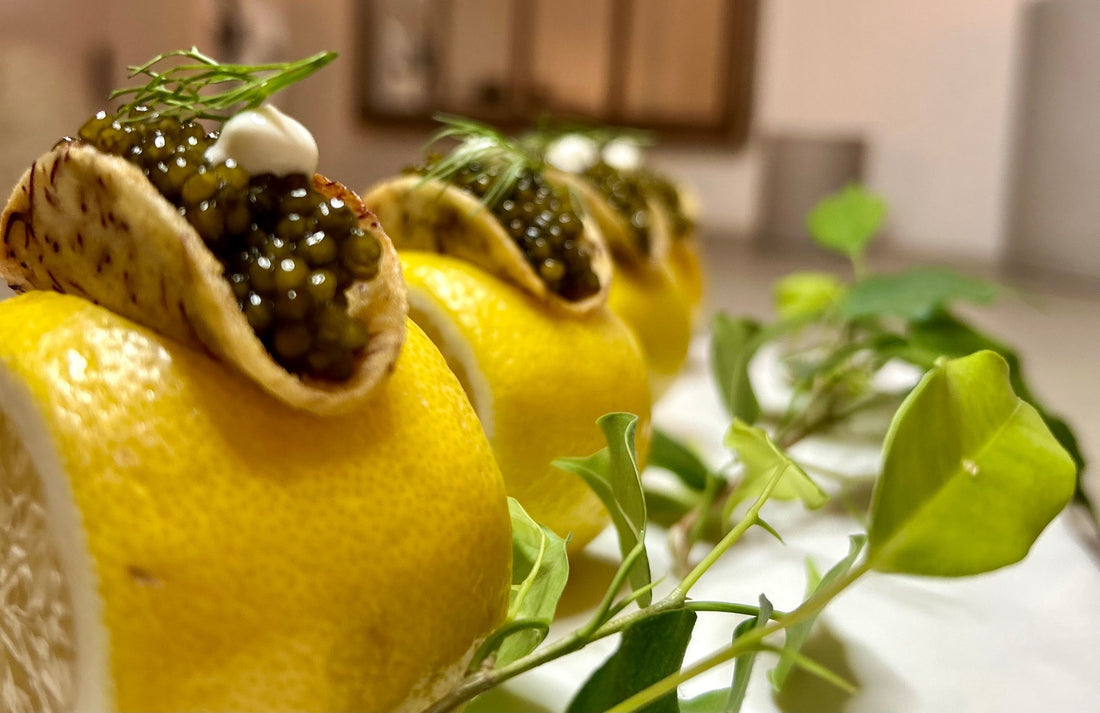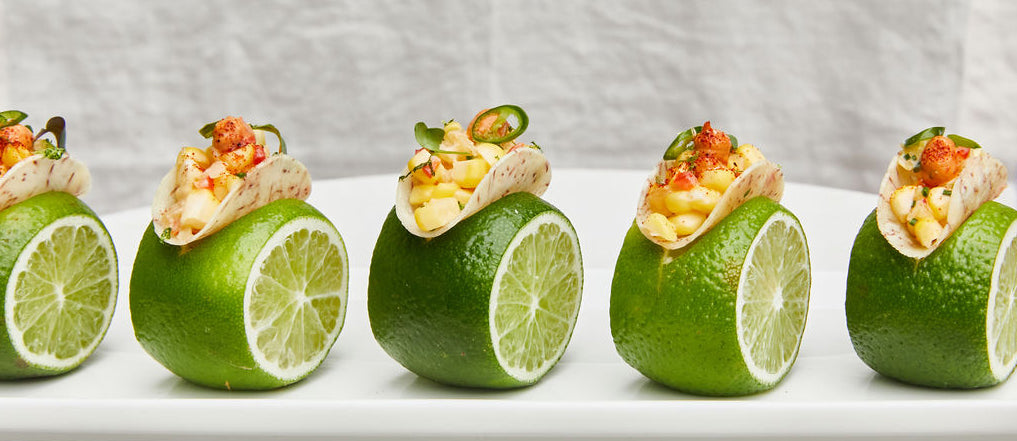
Understanding Fine Dining vs. Upscale and Casual Catering
Appetizers play a crucial role in the culinary world. They introduce a meal; setting the stage for your dining experience. Fine dining restaurants, upscale events, and casual gatherings often kickoff with appetizers. We distinguish between these culinary categories by looking at examples of their appetizers. But first let's explore their origins, history, and definitions.
History and Origins of Fine Dining, Upscale Catering, and Casual Catering
Fine Dining:
Origins and Definition:
Fine dining traces back to 18th-century France, during the reign of Louis XIV. The king kicked off what would become an elaborate dining culture. Haute cuisine means "high cooking" in French. In the 18th and 19th centuries haute cuisine formalized dining as an art form.
The French tire company launched the Michelin Guide in 1900. This further cemented fine dining’s prestige. The guide introduced a system to rate the best restaurants globally. We still respect this system today[1].
What is Fine Dining?
Fine dining elevates the dining experience. This means exquisite flavors, precise techniques, top-tier ingredients, and an impeccable service standard. The elegance of a fine dining atmosphere shows attention to every detail, from setting to dress code. Meals often include multiple courses, with small portions and intricate presentation[2].
How Fine Dining Works:
In a fine dining establishment, the curate every aspect of the dining experience. Guests can expect tablecloths, formal service, and seasonal, high-quality ingredients.
Chefs like Thomas Keller, who's famous for his restaurant The French Laundry, and Daniel Boulud, a French cuisine pioneer, exemplify this artistry of fine dining.
Fine dining chefs often use cutting-edge techniques such as sous-vide cooking and molecular gastronomy. That's how they ensure the highest quality flavor and presentation[3].
Upscale Catering:
Origins and Definition:
Upscale catering originated as service catering for high-profile events. That means corporate gatherings, weddings, and galas. While fine dining restaurants focus on a set location, upscale catering brings the experience of refined dining to an event. These events could be located in a tent, ballroom, or private home.
Catering developed an upscale category in the 20th century. That's when caterers brought luxury dining at events outside traditional restaurants[4].
What is Upscale Catering?
Upscale catering combines elements of fine dining with the practical demands of catering. For instance catering brings portability and volume to the mix. The high quality of upscale catering food mirrors fine dining. Still, use of these primo ingredients requires adjustments for large-scale prep and transport.
Catered appetizers at upscale events are typically quite small. That means they're truly bite size for one handed ease. They're also beautifully crafted, and served in a way that maintains elegance. In the best cases to be easily consumed at a standing reception. That's why the tinier appetizer, the better[5].
How Upscale Catering Works:
Upscale caterers create sophisticated menus that reflect the latest food trends and global influences. The menu might feature bite-sized portions such as smoked salmon canapés or foie gras terrine served on delicate crackers.
Gavin Kaysen has the Michelin-starred restaurant Spoon and Stable. He's made a name for himself by taking the intricacy of fine dining and applying it to catering[6].
Casual Catering:
Origins and Definition:
Casual catering is more informal. It's evolved as demand for simpler, less fussy fare has increased. The event planning world has grown and shifted. It's become fast-paced with events popping up without extensive time for planning.
That's why social gatherings and events may shift toward more relaxed setups. The appeal of casual catering also grows with society's emphasis on comfort, ease, and abundance[7].
What is Casual Catering?
Casual catering focuses on delivering hearty, crowd-pleasing dishes prepared and served in large quantities. This enables less meticulousness than what's required in fine dining. Appetizers in casual catering are typically larger and less formal. They tend to be easy to serve in a variety of settings. Sometimes this means buffet style[8].
How Casual Catering Works:
Casual catering often presents a wide array of options that appeal to a broad audience. The food can be homemade or semi-homemade. Selections often featuring local or familiar ingredients.
Chefs working in this space may include Bobby Flay and Ina Garten. They're known for approachable, flavorful style that works well in informal gatherings[9].
Appetizer Examples for Each Category
Fine Dining Appetizers:
Fine dining appetizers are small and intricate. They're designed to tease the palate. They're typically served in truly bite size portions. This gives diners a taste of what's to come without overwhelming them. It also makes eating them easy and mess free. Just pop them on your mouth one handed!
- Foie Gras Mousse with Brioche – A luxurious preparation of foie gras served with delicate toasted bread.
- Oysters Rockefeller – Fresh oysters baked with spinach, cheese, and a touch of Pernod.
- Caviar with Crème Fraiche and Blini – A refined combination of briny caviar served with a dollop of creamy crème fraiche on a small blini.
- Tiny Taro Tacos – Inspired by innovative small plates, these mini tacos combine a crispy taro shell and flavorful fillings. They're a creative twist on traditional appetizers, offering a unique blend of texture and taste [10].

The Importance of Single-Bite Appetizers in Fine Dining
In fine dining, single-bite appetizers are coveted. That's because they create a sense of sophistication and surprise. These bite-sized morsels allow guests to experience complex flavors in a manageable form.
Single-bite appetizers also showcase the chef's technique on a tiny scale. Preparation and presentation must be impeccable to deliver a complete flavor experience in just one bite.
The small size also encourages guests to savor each moment. This enhances the overall multi-course dining experience. Focusing on intricate details, these appetizers set the tone for the rest of the meal.
Upscale Catering Appetizers:
Upscale catering appetizers maintain a high standard of taste and presentation, but they must be portable and easy to serve. These appetizers are typically bite-sized and elegant.
- Mini Beef Wellington – A tiny, portable version of the classic dish, perfect for catering events.
- Shrimp Cocktail Shooters – A modern take on the classic, served in mini cocktail glasses.
- Bruschetta with Tomato, Basil, and Balsamic Reduction – A twist on the traditional Italian appetizer, served as a tiny, elegant finger food.
Casual Catering Appetizers:
Casual catering appetizers are designed for ease and convenience. They allow guests to help themselves to hearty portions. These appetizers are often larger, more filling, and less intricate. You might need a plate!
- Pulled Pork Sliders – A popular choice, offering comfort food in a small, handheld sandwich format.
- Vegetable Spring Rolls – Light, crunchy rolls stuffed with vegetables, often served with dipping sauce.
- Nacho Bar – A fun, interactive option where guests can build their own version from a variety of toppings.
Size and Presentation of Appetizers
The size and presentation of appetizers vary significantly across these three categories:
- Fine Dining Appetizers - typically very small, often served in bite-sized portions that allow guests to savor complex flavors. The presentation is delicate and often artistic, with attention to color, shape, and texture.
- Upscale Catering Appetizers - also small but designed for ease of consumption at events, often served in small cups, spoons, or as finger foods that guests can easily hold while socializing. Presentation is still important, but functionality is key.
- Casual Catering Appetizers - usually larger, designed to be more filling and easy to serve in large quantities. These appetizers are often served buffet-style or in larger platters.
Pros and Cons of Fine Dining Appetizers for Events
Pros:
- Elevated Experience: Fine dining appetizers add sophistication and a sense of luxury to an event. This appeals to guests who appreciate high-quality ingredients and intricate flavors.
- Memorability: The uniqueness and creativity of fine dining appetizers can make an event stand out. This level of special creates lasting impressions.
- Portion Control: Smaller portions ensure that guests can enjoy multiple courses. They won't feel too satiated before the main meal.
Cons:
- Cost: Fine dining appetizers can be significantly more expensive. That's due to top quality of ingredients and preparation required.
- Quantity: Because they're smaller, more appetizers may need to be ordered to ensure there is enough food for all guests.
- Service: Fine dining requires impeccable service. This can be challenging to execute well at large events.
Of course, fine dining calls for refined presentation on all levels. That's the appeal! Many upscale caterers have systems for bringing this refinement to parties. But, if you'd like a more chill event, casual catering is always an option.
Conclusion
The choice of appetizers for an event greatly depends on the desired atmosphere and the audience’s expectations. In a restaurant, fine dining appetizers offer an exquisite, refined experience. They deliver small, intricate portions that emphasize flavor and presentation.
Upscale catering provides a similar high standard of food. But it also focuses on ease of service and portability. This makes upscale catering ideal for larger events.
Casual catering, on the other hand, emphasizes comfort and abundance. That makes it perfect for informal gatherings. Each type of culinary experience brings its own benefits and challenges, and the selection of appetizers should align with your tone and goals of the event.
Footnotes
- Michelin Guide. (2021). The Birth of Fine Dining: Michelin’s Origins. Michelin Guide. https://guide.michelin.com
- Kimes, M. (1999). The French Culinary Revolution and the Rise of Fine Dining. Oxford University Press.
- Keller, T. (2016). The French Laundry Cookbook. Art of Fine Cooking.
- Gagnaire, P. (2003). Catering Excellence: From Fine Dining to High-End Events. Catering Insight.
- "Upscale Catering: An Art of Creating Elegance." (2021). Catering Professional Journal. https://cateringjournal.com
- Kaysen, G. (2015). Spoon and Stable: Bringing Fine Dining to the Table. Minneapolis Press.
- Smith, J. (2018). Casual Catering: A Shift Toward Simplicity and Comfort. Modern Event Catering. https://eventcatering.com
- Flay, B. (2009). Bobby Flay’s Grill It! The Art of Casual Cooking. Crown Publishing.
- Garten, I. (2017). Make It Ahead: A Cookbook. Clarkson Potter.
- Tiny Taco BK. (2023). Tiny Taro Tacos: A Modern Twist on Traditional Appetizers. Tiny Taco BK. https://tinytacobk.com

